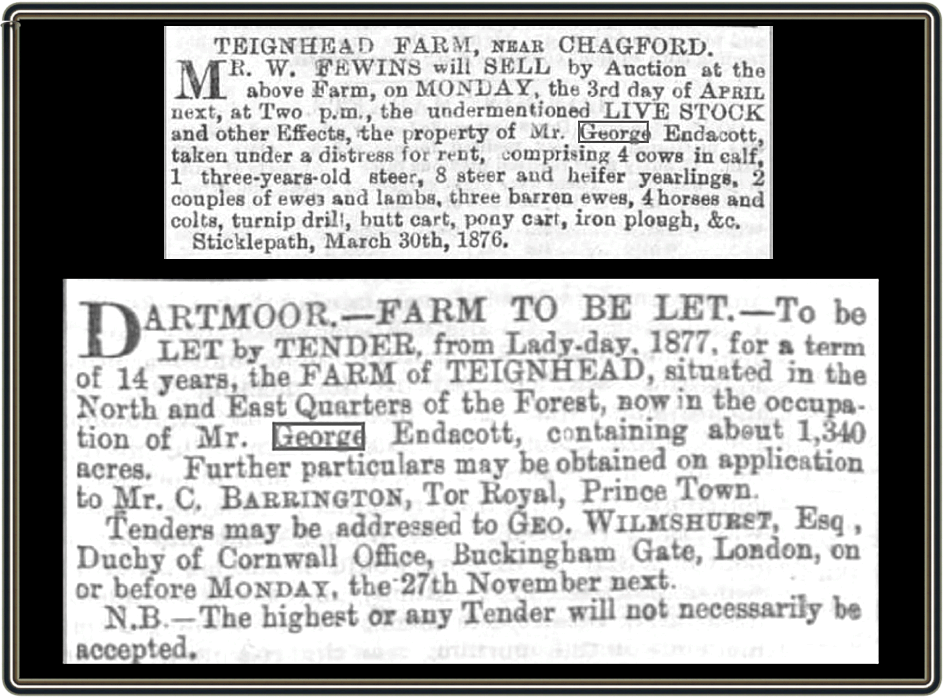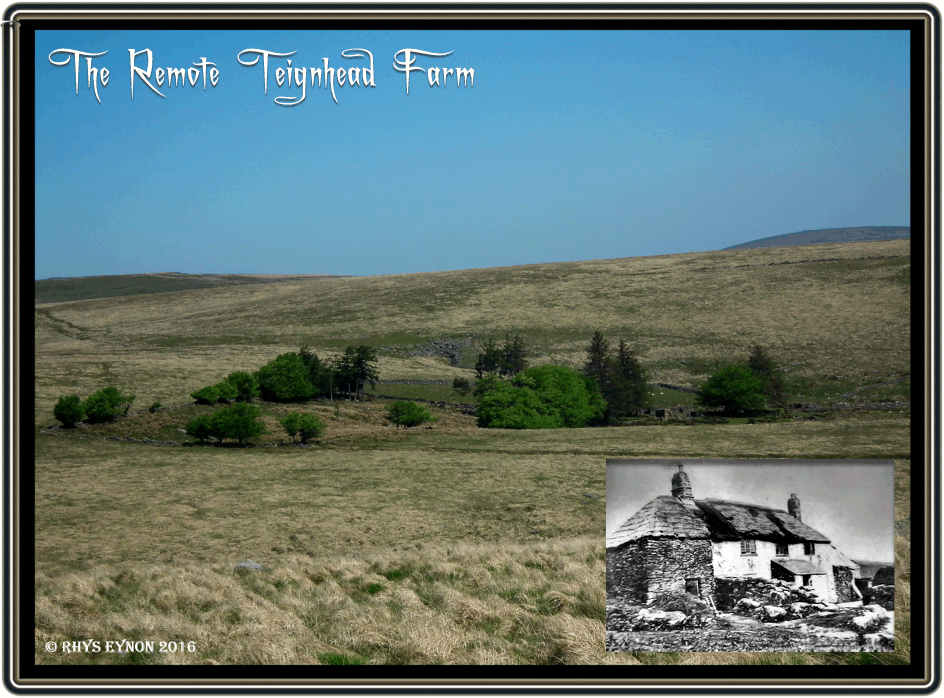
“… the noted Teign Head George. George was quite a character in his way, and though reared in a remote spot where little or no association with his fellows was to be found, developed a great liking for company nevertheless. The neighbouring village of Chagford knew him often, he had evidently no notion of spending all his time at his lonely farm. But he was not master of it for long; only a brief three years…” Crossing, p.7.
In the quote above William Crossing is writing about George Endacott and as he rightly says was also known as ‘Teignhead George‘ due to the fact that he was once tenant there. Crossing is also correct when he says that George Endacott was ‘quite a character‘ although that is rather understating the fact. In the 1871 census George Endacott he appeared as living at Teignhead Farm with his mother and brother Samuel and according to the census was 30 years of age and unmarried. George took over the lease of Teignhead Farm following the death of his father James who died in 1870. It seems as things were no going too well for George because in 1875 his rent was in arrears. At the time the Duchy of Cornwall Steward, Charles Barrington wrote; “from what I can learn, Mr. Endacott has, for some time past, been leading a very unsteady life and neglecting his business so much that his relations are doubtful if his mind is not affected.” In 1876 he was once again in arrears with his rent and it was decided to send in the bailiffs. According to Stanbrook some relatives of George lent him the rent money and the action was called off. Later in that year he was sent to gaol for a month for being drunk and disorderly. This left the farm unattended and so his relatives moved what little livestock he had left to Gidleigh for safe keeping.. Stanbrook, pp 24 – 25. In the March of 1876 it was announced in the local press that under a distress for rent order made against Endacott some livestock was to be auctioned along with various carts, drills and a plough (see extract below). What is not certain is whether or not this announcement was made prior to George’s relatives lending him the money to pay the arrears and was then cancelled? In the September of 1826 the Duchy served George with a notice to quit Teignhead Farm and the place was put out to tender (see extract below). The letter from the Duchy read:
“To Mr. George Endacott,
As the agent for and behalf of His Royal Highness Albert Edward Prince of Wales and Duke of Cornwall I hereby give you notice and require you to quit or yield up to His said Royal Highness Albert Edward Prince of Wales and Duke of Cornwall the quiet possession of All those closes or pieces of land and premises with the dwelling house and other buildings thereon called Teignhead Farm – C. Barrington.” Hemery, p.814.
As briefly mentioned above, George Endacott liked a pint or two or maybe even ten and was often summonsed before the magistrates for being drunk and disorderly, the following are but a few of the occasions when he appeared at various courts:
August 1872 – George Endacott, a farmer, of Teignhead in the parish of Lidford was summonsed for cruelty to a pony. P. S. Hobbs stated that on the night of the 19th of July, defendant was riding a pony in Ashburton. He was very drink and noisy, and ultimately got locked up for the night. The pony was taken to the Duke’s Head and on taking off the saddle they saw a wound on the back-bone about two inches in diameter, and there was blood – and matter running from it – fined £1 and 15 shillings cost.
June 1874 – George Endacott, a farmer of Lidford, was charged with being drunk and disorderly at Newton on the previous evening – P.C.s Setter and Salter proved the case and the bench fined him 20 shillings and costs.
August 1877 – George Endacott, better known as ‘Teignhead George’ was summonsed for the twenty sixth time for being drunk and disorderly at Chagford on the 27th inst. P. C. Mills proved the case. Defendant did not appear – fined £2 and costs.
April 1878 – George Endacott, who did not appear, was fined ten shillings and eight shillings and six pence costs, or fourteen days, for evading a toll at the Okehampton Gate on Monday last.
September 1878 – George Endacott, labourer, of Chagford, was charged by P. C. Mills with being drunk and disorderly on the 17th of August. This being his 23rd appearance before the magistrates, he was fined £2 and costs.
October 1895 – George Endacott, son of a farmer, was charged with riding a horse furiously and also with being drunk. Defendant pleaded guilty to both charges. P. C. Huriord (?) said there were several people about at the time, it being market day. Defendant who expressed sorrow, was fined fifteen shillings for the first offence and ten shillings for the second.
I would suggest that part of the reasons he could never pay his rent was that much of what little money he did have was spent either on drink or fines as can be seen above. If you use an inflation rate calculator based on 1877 the above fines alone equate to a minimum of £728 (excluding undisclosed costs) in today’s money.
Now that is one portrait of George Endacott but I recently came across a puzzling article which appeared in the Western Times on the 14th of May, 1943 whose title was;
“The Saint of Dartmoor‘ – The article starts of with; “Indeed, many saintly characters are already enshrined in our literature but one of whom I now write was only known to the small community in which he moved in one of the most remote parts of Dartmoor. Yet in those parts, his memory will never fade, for it is inspiring, true, and lasting. I refer to George Endacott, who used to live at Teignhead Farm, which is within a few paces of the tributary of the River Teign… I happened to mention to Mr. Perryman how impressed I was with the faithful and happy congregation of Providence Chapel Throwleigh, and this at once recalled memories of George Endacott, and what I heard of this quite, unassuming, God-fearing man, made me marvel at his devotion to his church.”
Apparently he suffered from severe rheumatism but despite the pain would walk every Sunday to Providence Chapel at Throwleigh from his home at Teignhead Farm. No matter the time of year or the weather conditions he would make his journey to the chapel where he would stay all day attending services and Sunday School. The five mile journey would take him from the farm and across to the Teign-e-ver clapper bridge and then on past Scorhill Circle. From there he would trudge across Gidleigh Common to Creaber Pound from whence he would make his way to the chapel. Once the Sunday worship was over he would then walk the five miles back to Teignhead Farm. There were occasions when winter storms prevented his return home and seemingly he would make; “the best of it wherever he was.” The author finally goes on to remark;
“When wandering through that quiet burial ground which almost adjoins Providence Chapel, I noticed a headstone bearing the name of one, George Endacott, who died about forty years ago and I believe this marks the grave of George Endacott, the Saint of Dartmoor, of whom I have been privileged to write. Here this stout-hearted son of Devon takes his long rest near the church where he loved to worship, and which he served so loyally. As we left the burial ground we both felt that it would gladden the heart of John Wesley himself if he heard about the devotion of this simple hearted farmer, a great Christian, who was his master’s follower to the end.”
Now does that sound like the same man? As far as I can discern there was only ever one George Endacott who lived at Teignhead Farm so unless there was a dramatic ‘Road to Damascus’ moment in later life something is not quite right here. Did the author get confused with another Endacott? Clearly not as he saw what he supposed was George’s grave. Were the above reports of George’s drunkenness wrong? Again, clearly not as several authors have recorded the fact along with various newspaper reports. So in the end one has to decide for themselves – was he ‘The Saint of Dartmoor’ or not?
Incidentally, there must be something in the air at Teignhead Farm that leads to over imbibing in alcohol as in 1897 one James Brock took up the tenancy of the farm. Old moormen have told stories how James would get as ‘tight as a mattress’ and be unable to walk, at which point the Princetown locals would bundle him in his cart and let the horse take him home.

Crossing, W. 1986. The Teign from Moor to Sea. Brixham: Quay Publications.
Hemery, E. 1983. High Dartmoor. London: hale Publishing.
Stanbrook, E. 1994. Dartmoor Forest Farms. Tiverton: Devon Books.
 Legendary Dartmoor The many aspects past and present of Dartmoor
Legendary Dartmoor The many aspects past and present of Dartmoor


